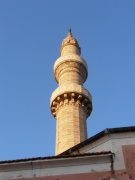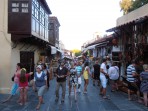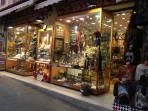Turkish domination - Rhodes island

The Johannite rule lasted until 1552, when Sultan Suleiman attacked the island of Rhodes with a huge fleet of Turkish ships. After a long siege, the city finally surrendered and Rhodes became part of the Ottoman Empire. Under Turkish rule, however, the island's commercial and cultural influence declined, several earthquakes struck the area and Rhodes disappeared from the international scene. The Turks occupied the island until 1912.
The knights of the Order of St. John were able to successfully withstand the raids of various conquerors for more than two hundred years thanks to the quality of their fortifications. The turning point came in 1552, when the Turkish Sultan Suleiman, nicknamed the Magnificent, landed on Rhodes and launched a siege with a fleet of 200 warships. The siege of the island lasted for six long months and both sides were exhausted. It is said that the Sultan finally won thanks to the treachery of one of the locals, who confided in him that the city's defences were already at the end of their strength. The Turks struck the island once more with great force and captured the fortress. The last Grand Master of the Johannite Order, Villiers de l`Isle Adam, was thus forced to hand over control of the island to the Turkish Sultan and Rhodes became part of the Ottoman Empire.
After the surrender, 180 knights were left behind and allowed to sail. The Knights found a new home in Malta and were given the name by which they are still known today - the Knights of Malta. The knights also took with them 8,000 Christians, a collection of art, church standards and relics.
Although the Turks effectively conquered the island and the city of Rhodes became the capital of the Aegean province of the Ottoman Empire, they never managed to subdue the local population. Under Turkish rule, Rhodes was rather deserted, with the occasional temple converted into a minaret or manor house, and Turkish baths were also built in the capital. However, the Turks did not show much interest in architecture and culture on the island and the towns slowly depopulated. The island's main economic force was agriculture, and until the 19th century, Rhodes functioned as a market for agricultural supplies for its own use and for the surrounding small states. However, its international importance was declining.
During the Turkish occupation, the island was ruled by Kapudan Pasha and was also home to the chief administrator of the Aegean province of the Ottoman Empire, of which Rhodes was a part. However, only Turks and Jews were allowed to live in the Old Town, and the locals had to move to new suburbs outside the walled city. Greek workers who worked in the Old City were driven outside its walls every evening. This is how the New Town was created.
But the Turks never managed to take over the whole island and were always a minority on Rhodes. Even so, some towns managed to maintain a degree of independence, including economic activity - notably Lindos. In 1821 the mainland Greeks rebelled against the Turks and gained their independence. But the Rhodenians were too exhausted and remained under Turkish rule. The Turks occupied the island until 1912.
Sights:
400 long years of Turkish rule had done its toll on Rhodes. The once thriving island has gradually fallen into disrepair and decay, including architectural and artistic activity. The Turks took little care of the buildings and did not repair them. This was exacerbated by several strong earthquakes that hit the island. Some of the buildings were demolished, some churches were occasionally converted into minarets. A few mosques and public baths were built in the capital. Today, this part of the Old Town is known as the "Turkish Quarter".
Did you visit this place and do you have some additional informations, interessting observation or photos?




